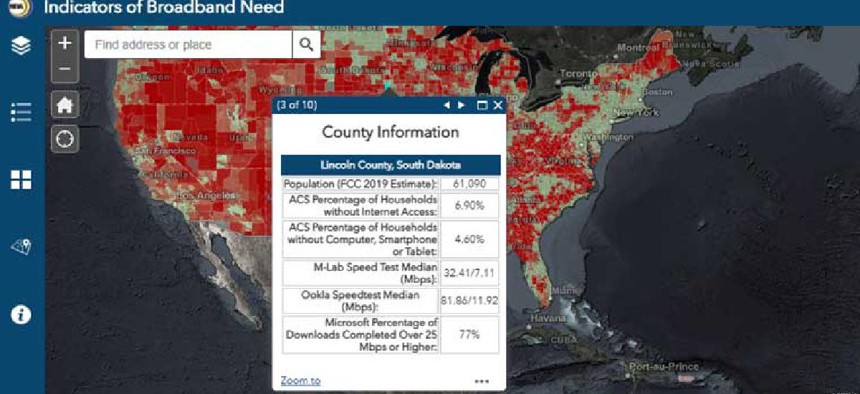NTIA’s interactive map visualizes digital divide

A new interactive digital map allows users to explore different datasets about where people lack quality broadband access.
A new interactive digital map allows users to explore different datasets about where people lack quality broadband access.
The National Telecommunications and Information Administration’s “Indicators of Broadband Need,” which features data from both public and private sources, helps illustrate which parts of the country report internet speeds that fall below the Federal Communications Commission’s current benchmark for fixed broadband service: 25 Mbps downstream, 3 Mbps upstream.
The map contains data aggregated at the count, census tract and census block level from the Census Bureau, the FCC’s Form 477, on which internet service providers report fixed broadband speeds that meet the FCC’s benchmark, and speed test data from M-Lab, Ookla and Microsoft. This is the first map that allows users to graphically compare and contrast these different data sources, NTIA officials said.
Using the Census’ American Community Survey from 2015-2019, the map also draws a line between poverty and lack of broadband access. Users can see internet usage patterns in high-poverty areas and tribal communities, as well as their lack of computers and related equipment. Toggling the layers on and off allows users to compare information for specific locations so they can gain a better understanding of where broadband needs are greatest.
The NTIA map is the latest effort to better identify gaps in high-speed internet services. In March, the FCC tasked its Broadband Data Task Force to develop the necessary tools to gather more accurate and granular broadband access data from ISPs, the public, state, local and tribal governments, other federal agencies as well as third parties, such as companies specializing in broadband mapping and data collection. The agency also said it planned to refine the data over time through crowdsourcing, audits and verification and enforcement actions.
“Broadband is no longer ‘nice to have.’ It’s ‘need to have.’ To ensure that every household has the internet access necessary for success in the digital age, we need better ways to accurately measure where high-speed service has reached Americans and where it has not,” FCC acting Chairwoman Jessica Rosenworcel said. “The latest mapping effort by NTIA is a welcome new tool that provides valuable insight into the state of broadband across the country.”
“Any effort to close the digital divide starts with solid data, and NTIA continues to help policymakers make more informed decisions on expanding broadband access,” acting NTIA Administrator Evelyn Remaley said. “Now, the public can benefit from our platform to see which areas of the country still don’t have broadband at speeds needed to participate in the modern economy.”





